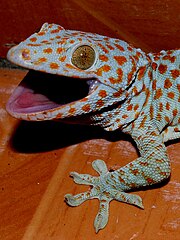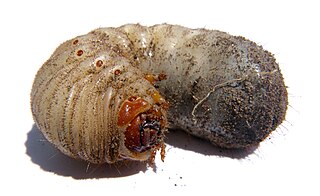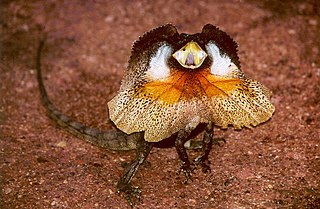What DO Leopard Geckos Eat?! The Leopard Gecko, Eublepharis macularius, makes a wonderful pet for novices and advanced hobbyists alike (even after many years as a professional zookeeper, I enjoy keeping them, and wrote a book about their care). However, both sellers and buyers sometimes underestimate this delightful lizard’s needs, especially where feeding is concerned. Contrary to popular belief, vitamin-powdered crickets and mealworms do not constitute a suitable diet! If you wish your pet to live out its potential lifespan of 20-30 years in excellent health, you’ll need to provide it with as many different foods as possible. Fortunately, a surprising array of insects can be purchased online and in stores. Collecting and rearing your own insects is another excellent way to add to your gecko’s quality of life…and its great fun as well! Read More »
Category Archives: Geckos
Feed SubscriptionTokay Gecko Care, Feeding and Terrarium Design
Pugnacious reptiles with “attitudes” have long been favored by herp enthusiasts. In the lizard world, perhaps none fits this description so well as the Tokay Gecko, Gekko gecko. It truly is the ultimate “big lizard in a small package”. Years ago, I liberated a group into a huge multi-species exhibit at the Bronx Zoo, mainly for my own interests. Although my fellow keepers were well-experienced in caring for venomous snakes, dangerous primates and the like, I was roundly criticized…no one wanted to chance accidentally grabbing one of these foot-long nocturnal terrors! But in the right hands (well, not literally “in hand”…most object strenuously!), Tokay Geckos make fascinating pets that may live into their 20’s. What’s more, they are beautifully-clad in an array of colors, and are not shy about exhibiting their behaviors, including reproduction.
Natural History
This accomplished vocalist draws its common name from the loud cries of “tokay, tokay” given by the territorial males. Some years ago a pet store in Manhattan began renting them to customers as a form of “natural” roach control. However, their habit of vocalizing in the wee hours of the morning doomed the scheme to failure. Read More »
Spectacular New Species of Leaf-Tailed Gecko Discovered in Australia
Madagascar’s bizarre Leaf-Tailed Geckos (Uroplatus spp.) are on the wish lists of many lizard enthusiasts. Even after decades of keeping reptiles in zoos, I was shocked by the sight of my first specimen. Equally unique are Australia’s fantastic Leaf-Tailed Geckos (genus Saltuarius). In color, shape (some look like insect-chewed leaves!), movement and body position, both groups take camouflage to its extreme. The recent (October, 2013) discovery of a new Australian species, the Cape Melville Leaf Tailed Gecko, has caused quite a stir. Its Latin name means “exceptional, extraordinary and exquisite”…and it is very fitting! I know that I’m not alone in being thrilled that there are still such unusual creatures waiting to be found.
A Tiny Range and Very Specific Habitat
The Cape Melville Leaf Tailed Gecko, Saltuarius eximius, seems limited in distribution to the Cape Melville Mountains on the Cape York Peninsula in tropical northeastern Queensland, Australia.
Only 6 individuals have been found, all on granite boulders beneath a rainforest canopy (please see habitat photo). This same mountain range is also home to 3 endemic (found nowhere else) frogs and 2 endemic skinks. Read More »
How to Feed Insect-Eating Pet Lizards – the Best Live Foods
From tiny Day Geckos to stout Water Dragons and lumbering Savanna Monitors, many popularly-kept lizards feed primarily upon live foods including insects and other invertebrates. The most important point for insectivorous lizard owners to remember (and one that my regular readers are sick of seeing!), is that crickets and mealworms alone, even if powdered with supplements, are not an adequate diet for any species. Dietary variety is essential. Fortunately, with a bit of planning, we can collect, breed or purchase a huge array of nutritious invertebrates for the lizards in our collections.
From specialists such as Horned and Caiman Lizards to Tokay Geckos and other generalists, the needs of individual species vary greatly. Please post below for specific information on the lizards in your collection.
Wild Caught Insects
I firmly believe that reptile keepers should place much more emphasis on collecting insects and other invertebrates. While caution concerning pesticides and toxic species is warranted (please see articles linked below), the risks can be managed. Some notable successes that I and colleagues have had with a variety of delicate reptiles can be credited in part to the use of wild-caught insects. Read More »
Pet Lizards – Fascinating Species for those who keep Reptiles as Pets
From minute House Geckos to massive Water Monitors and endangered Rhinoceros Iguanas, an amazing array of fascinating lizards is now available in the pet trade. Fortunately, many are being bred in captivity, and new discoveries concerning their needs occur regularly. But the range of choices of pet lizards can be overwhelming. Not all species are suited for each keeper, and some, although popular, are best avoided by private collectors.
Drawing from decades of work with hundreds of species at the Bronx and Staten Island Zoos, today I’d like to highlight the pros and cons of some popular lizards. Detailed care information can be found in the linked articles, or by posting your questions below. Scores of other species could be used in place of those I have suggested…please be sure to write in with your own favorites, so that other readers may benefit from your experiences.
Chuckwalla (Sauromalus obesus)
This stocky desert-dweller was once difficult to maintain in captivity, mainly because its UVB requirements were ignored. Today’s high-output florescent UVB and mercury vapor bulbs have changed this situation, and captive bred animals are now readily available. Read More »
 That Reptile Blog – Reptile, Amphibian and Exotic Pet Care and Information
That Reptile Blog – Reptile, Amphibian and Exotic Pet Care and Information





